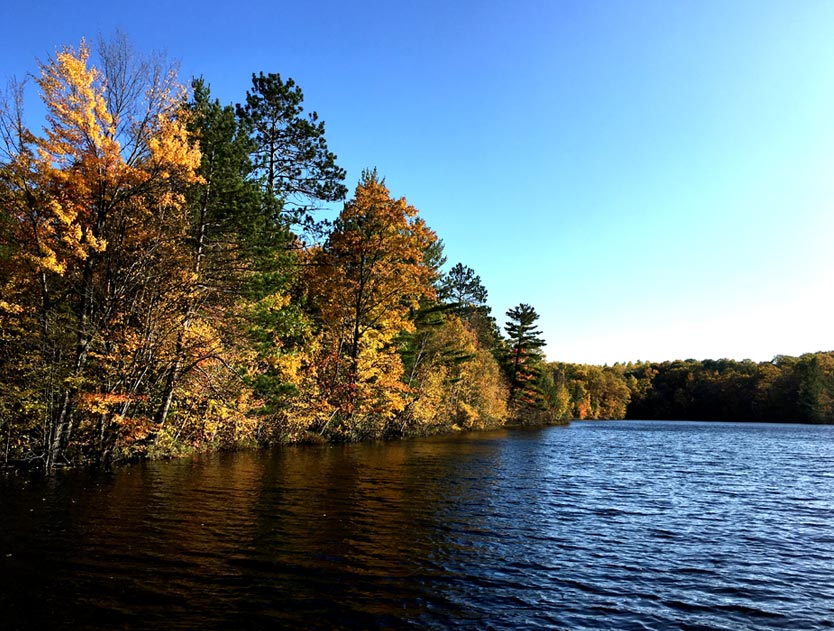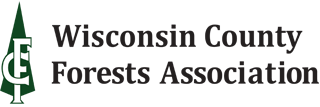Providing leadership to the county forest program ensuring long-term forest health and sustainability
Watershed Protection
 Wisconsin has more than 15,000 lakes covering nearly 1 million acres, over 5 million acres of wetlands and over 12,600 rivers and streams which flow more than 84,000 miles through forests, wetlands and grasslands. Forests play an important role in the water cycle, contributing to the high quality of water found in Wisconsin’s lakes, streams and wetlands. In addition, forests not only contribute directly to Wisconsin’s economy but also indirectly, supporting water-based activities and economies. Sport fishing and waterfowl hunting alone generates over $2.7 billion annually in business, and provides more than $200 million in tax revenue for local and state government.
Wisconsin has more than 15,000 lakes covering nearly 1 million acres, over 5 million acres of wetlands and over 12,600 rivers and streams which flow more than 84,000 miles through forests, wetlands and grasslands. Forests play an important role in the water cycle, contributing to the high quality of water found in Wisconsin’s lakes, streams and wetlands. In addition, forests not only contribute directly to Wisconsin’s economy but also indirectly, supporting water-based activities and economies. Sport fishing and waterfowl hunting alone generates over $2.7 billion annually in business, and provides more than $200 million in tax revenue for local and state government.
The quality of these water resources as they flow through Wisconsin’s forests is a reflection of the management of our forests. For forestry activities, it is critical to understand where water is coming from and where water is going. The amount of timber harvested or the construction of a road can affect how water runs off a site and where that water goes. By knowing where, when, and how much water flows onto a site, one can determine the best locations for roads and skid trails, as well as what types of “Best Management Practices” (BMP) will be needed to manage water flow.
Most of the water in a forest comes from rainfall or snowmelt, and will soak into the ground until the soil is saturated. Water will then begin to flow over the forest floor, heading downhill until there is enough concentrated flow for a stream to develop, or some cases, the water which soaks into the ground may be discharged into springs and seeps, returning to the surface. All the land that drains to a given point is a watershed, and all lakes, streams, and wetlands reside within watersheds. Watersheds can range in size from just a few acres to thousands of acres. Regardless of where a property is found, it is part of a watershed.
County Forest staff actively protect watersheds by maintaining healthy forests along waterways and wetlands including forested buffers which may be left undisturbed during timber harvests. Well-managed forests filter water to provide outstanding warm and cold-water streams and lakes for trout and other fisheries, beaver and otter, waterfowl and amphibians. Many county forests also manage flowages with their associated dams and water control structures to provide recreation opportunities including wild rice harvesting.
The most practical and cost-effective method to assure forestry operations do not adversely affect water quality on county lands is to utilize the BMPs as described in Wisconsin’s Forestry Best Management Practices for Water Quality (Publication FR-093). BMPs are designed to protect general water quality, water temperature, nutrient balances, habitat diversity and hydrologic processes among others, and are used widely amongst all county forests with the understanding they may be modified for specific site conditions with guidance from a forester or other natural resource professional. The Wisconsin Department of Natural Resources employs forest hydrology specialists which aid in numerous projects on county lands and are available for consult and advice. Any modifications to the BMPs will provide equal or greater water quality protection or have no impact on water quality, and will be fully documented in the timber management plan and silvicultural prescription. County staff receive BMP training and additionally, logging contractors are highly encouraged to be trained as well in water quality best management practices.
For More information visit the DNR’s watershed page >
